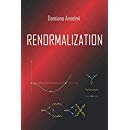The classical action of quantum gravity, determined by renormalization, contains infinitely many independent couplings and can be expressed in different perturbatively equivalent ways. We organize it in a convenient form, which is based on invariants constructed with the Weyl tensor. We show that the FLRW metrics are exact solutions of the field equations in arbitrary dimensions, and so are all locally conformally flat solutions of the Einstein equations. Moreover, expanding the metric tensor around locally conformally flat backgrounds the quadratic part of the action is free of higher derivatives. Black-hole solutions of Schwarzschild and Kerr type are modified in a non-trivial way. We work out the first corrections to their metrics and study their properties.
JHEP 1305 (2013) 028 | DOI: 10.1007/JHEP05(2013)028
Welcome to RENORMALIZATION.COM
Here you can read papers, theorems and books about renormalization and quantum field theory in general, as well as discuss about open problems, address new projects and ideas. More details here
For queries and suggestions send an email to r enor mal ize@r enor mal izat ion.c om
Consider a functional integral
\[
\mathcal{I}=\int [\mathrm{d}\varphi ]\hspace{0.02in}\exp \left( -S(\varphi)+\int J\left( \varphi -bU\right) \right) ,
\]
where $U(\varphi ,bJ)$ is a local function of $\varphi$ and $J$, and $b$ is a constant. Then there exists a perturbatively local change of variables
\[
\varphi =\varphi (\varphi ^{\prime },b,bJ)=\varphi ^{\prime }+\mathcal{O}(b),
\]
expressed as a series expansion in $b$, such that
\[
\mathcal{I}=\int [\mathrm{d}\varphi ^{\prime }]\hspace{0.02in}\exp \left(
-S^{\prime }(\varphi ^{\prime },b)+\int J\varphi ^{\prime }\right) ,
\]
where $S^{\prime }(\varphi ^{\prime },b)=S(\varphi (\varphi^{\prime },b,0))$.
The idea to create this website came while completing a book about renormalization, which will be freely readable at this page once ready. I realized that the best way to disseminate knowledge, nowadays, is not to write a book. One must at least make the book “alive”, which is possible, for example, with the help of a website. I figured out that since a website is much more versatile than a book, it allows me to provide a much richer service.
Why renormalization? Because it is the main interest of my research, and because I think it has a lot to teach us, in a broad sense.
Renormalization is one of the deepest aspects of quantum field theory, and quantum field theory is one of the greatest successes of theoretical physics, certainly the most advanced achievement of high-energy particle physics.
In recent years several aspects of quantum field theory have been neglected, and the attention of theoretical physicists has been effectively diverted towards model building and other, more “horizontal”, approaches. Renormalization and several other important topics have been buried under a huge number of scientific papers on topics of questionable relevance. Existing repositories and archives do not even offer efficient searching tools. They do not allow visitors to single out papers about renormalization or other topics that are worth of special attention.
Nowadays technology allows us to copy, and save, and backup. This gives us the impression that no knowledge is at risk to be lost. In a variety of unfortunate circumstances, several times in the past huge amounts of knowledge have been lost or buried underground and forgot there for a long time. Sometimes the lost knowledge was uncovered centuries later, some other times it was lost forever. We know that this cannot happen today, in principle.
Till a decade ago, I was convinced that I did not need to insert the words “in principle” at the end of this sentence. However, on second thought, burying something underground is not very different from drowning it under the huge amount of questionable “information” that is normally produced and circulates on the internet. In both cases knowledge is still there, in both cases it needs to be discovered again, otherwise it is lost forever. In this respect, search engines are totally useless, since they mostly point to what is popular and liked by people, but they have no way to identify what is relevant.
These observations tell us that science is all but safe today. If knowledge can be forgot, it is easy to enter the path that leads to regress. We do not just risk to loose knowledge, actually, we also risk to forget the method to make progress and generate further knowledge. Very much like life, knowledge can be preserved only producing new knowledge. What new knowledge is produced today in theoretical physics? How many people can claim that theoretical physics is in good shape? And physics in general? and science?
One of the claims of this site is that, actually, the decline started long ago. We can reasonably say that the new era began around the early 1970s, when progress in theoretical physics reached its apex, then unexpectedly slowed down and eventually stopped. Since then theoretical problems have become more and more challenging. Partially because of this, but not only, wrong methods have been adopted to guide the scientific research, as well as wrong criteria to select and hire new people. Little by little the involution contaminated more and wider areas of research. For many reasons, it does not sound incorrect to dubb the era we have entered in “The New Middle Ages“. Probably becoming aware of this situation will not be enough to stop the decline, but it is the only hope we have.
So, I have enriched the initial project with more ambitious goals, to understand what it going on, discuss about the present situation and search for wayouts. If yuo feel you have ideas, you can help
If you wish to donate money for the maintenance of this site just buy the ebook or printed versions of the book Renormalization, as soon as it will be available.
For queries and comments about this site: r enor mal ize@r enor mal izat ion.c om
We study phenomena predicted by a renormalizable, CPT invariant extension of the Standard Model that contains higher-dimensional operators and violates Lorentz symmetry explicitly at energies greater than some scale $\Lambda_{L}$. In particular, we consider the Cherenkov radiation in vacuo. In a rather general class of dispersion relations, there exists an energy threshold above which radiation is emitted. The threshold is enhanced in composite particles by a sort of kinematic screening mechanism. We study the energy loss and compare the predictions of our model with known experimental bounds on Lorentz violating parameters and observations of ultrahigh-energy cosmic rays. We argue that the scale of Lorentz violation $\Lambda_{L}$ (with preserved CPT invariance) can be smaller than the Planck scale, actually as small as $10^{14}$-$10^{15}$ GeV. Our model also predicts the Cherenkov radiation of neutral particles.
Phys. Rev. D 83 (2011) 056010 | DOI: 10.1103/PhysRevD.83.056010
We consider renormalizable Standard-Model extensions that violate Lorentz symmetry at high energies, but preserve CPT, and do not contain elementary scalar fields. A Nambu–Jona-Lasinio mechanism gives masses to fermions and gauge bosons, and generates composite Higgs fields at low energies. We study the effective potential at the leading order of the large-$N_{c}$ expansion, prove that there exists a broken phase and study the phase space. In general, the minimum may break invariance under boosts, rotations and CPT, but we give evidence that there exists a Lorentz invariant phase. We study the spectrum of composite bosons and the low-energy theory in the Lorentz phase. Our approach predicts relations among the parameters of the low-energy theory. We find that such relations are compatible with the experimental data, within theoretical errors. We also study the mixing among generations, the emergence of the CKM matrix and neutrino oscillations.
Phys. Rev. D83 (2011) 056005 | DOI: 10.1103/PhysRevD.83.056005

 Quantum Gravity
Quantum Gravity 


